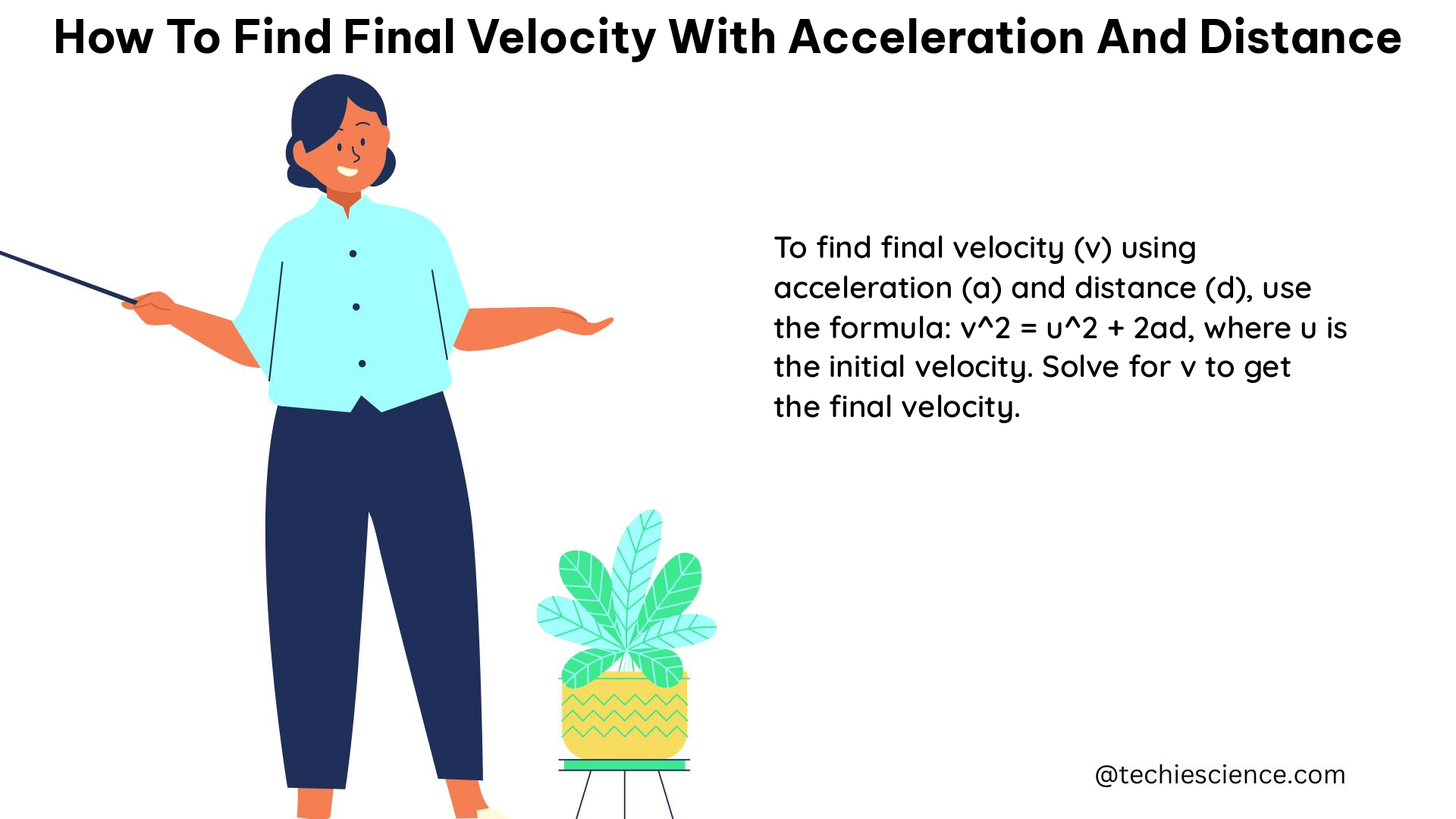Summary
Determining the final velocity of an object given its acceleration and distance traveled is a fundamental concept in physics. This comprehensive guide will walk you through the step-by-step process, providing detailed explanations, formulas, examples, and problem-solving techniques to help you master this essential skill.
Understanding the Kinematic Equation

The key formula used to find the final velocity of an object, given its acceleration and distance, is the kinematic equation:
$v^2 = u^2 + 2as$
Where:
– $v$ is the final velocity (in m/s)
– $u$ is the initial velocity (in m/s)
– $a$ is the acceleration (in m/s²)
– $s$ is the displacement or distance traveled (in m)
This equation is derived from the basic principles of motion and can be used to solve a variety of problems in physics.
Applying the Formula: Examples and Explanations
Example 1: Finding Final Velocity with Known Initial Velocity and Acceleration
Suppose an object starts with an initial velocity of 5 m/s and accelerates at a constant rate of 2 m/s² over a distance of 10 meters. To find the final velocity, we can plug the values into the formula:
$v^2 = 5^2 + 2 \times 2 \times 10$
$v^2 = 25 + 40$
$v^2 = 65$
$v = \sqrt{65} \approx 8.06 \text{ m/s}$
In this example, the object’s final velocity is approximately 8.06 m/s.
Example 2: Finding Final Velocity with Different Units
Consider a car that accelerates from 30 km/h to a final velocity over a distance of 200 meters. If the acceleration is 2 m/s², we need to convert the initial velocity to meters per second (30 km/h = 8.33 m/s) and then use the formula:
$v^2 = 8.33^2 + 2 \times 2 \times 200$
$v^2 = 69.44 + 800$
$v^2 = 869.44$
$v = \sqrt{869.44} \approx 29.47 \text{ m/s}$
In this case, the car’s final velocity is approximately 29.47 m/s.
Example 3: Finding Final Velocity with Time
If you know the time over which the acceleration occurs, you can use the formula:
$v = u + at$
For example, if an object accelerates from 10 m/s at a rate of 3 m/s² over 5 seconds:
$v = 10 + 3 \times 5$
$v = 10 + 15$
$v = 25 \text{ m/s}$
In this scenario, the object’s final velocity is 25 m/s.
Solving Numerical Problems
To further solidify your understanding, let’s work through some numerical problems:
-
An object starts with an initial velocity of 8 m/s and accelerates at a rate of 4 m/s² over a distance of 20 meters. Find the final velocity.
-
A car accelerates from 20 km/h to a final velocity over a distance of 150 meters. If the acceleration is 3 m/s², calculate the final velocity.
-
An object is initially moving at 15 m/s and undergoes an acceleration of 2.5 m/s² for 8 seconds. Determine the final velocity.
Solutions:
-
Plugging the values into the formula:
$v^2 = 8^2 + 2 \times 4 \times 20$
$v^2 = 64 + 160$
$v^2 = 224$
$v = \sqrt{224} \approx 14.97 \text{ m/s}$ -
First, convert the initial velocity to meters per second:
$20 \text{ km/h} = 5.56 \text{ m/s}$
Then, use the formula:
$v^2 = 5.56^2 + 2 \times 3 \times 150$
$v^2 = 30.94 + 900$
$v^2 = 930.94$
$v = \sqrt{930.94} \approx 30.51 \text{ m/s}$ -
Using the formula $v = u + at$:
$v = 15 + 2.5 \times 8$
$v = 15 + 20$
$v = 35 \text{ m/s}$
Key Takeaways
- The formula $v^2 = u^2 + 2as$ is used when you know the acceleration and distance.
- The formula $v = u + at$ is used when you know the acceleration and time.
- Ensure that the units of velocity, acceleration, and distance are consistent (e.g., meters per second for velocity and acceleration, and meters for distance).
- Practice solving a variety of problems to develop a strong understanding of the concepts.
- Refer to the provided examples and solutions to guide your problem-solving process.
References
I am Sakshi Sharma, I have completed my post-graduation in applied physics. I like to explore in different areas and article writing is one of them. In my articles, I try to present physics in most understanding manner for the readers.